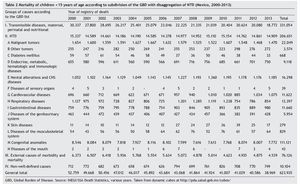Generally speaking, mortality due to nontransmissible diseases (NTD) refers to deaths of the population in general or specifically to a group of adults, considering that chronic degenerative causes are those that have registered the highest increase in recent decades for this population. In this sense, and based on the fact that previously the mortality of children < 15 years of age has been addressed in the Boletin Médico Hospital Infantil de México both for infectious diseases1 as well as for those due to violent2 or accidental3 causes, the analysis now presented refers precisely to mortality occurring as a result of NTD.
In Mexico, the number of deaths of children < 15 years of age was ~39,000 in 2013 (26% less than in 2000). Of these, 38% occurred as a result of some type of NTD. This proportion has been increasing because in 2000 it accounted for 29% of deaths. This can be explained by the significant progress in the health sector in the scope of infectious diseases despite the fact that they continue to be responsible for more than half of all deaths in this age group (Table 1). In terms of evolutionary rates, these have remained virtually constant over the period analyzed because, during those years, the population remained at ~33-34 million persons < 15 years of age.
For purposes of this communication, information generated by the death statistics of INEGI/SSA4 have been considered whose most recent final data correspond to the year 2013. The list of Global Burden of Disease (GBD) was considered because the ICD-105 presents NTD according to ten major subdivisions. According to a description of the demographic aspects of deaths occurring as a result of NTD in the early stages of life, males are most affected (54%), although with slight variations under specific conditions. With regard to age group, taking as a main category persons < 15 years of age, > 60% of deaths from these causes occur before the first year of life, followed by the 1- to 4-year-old age group.
Regarding the structure of mortality and because of its frequency, the majority of deaths are caused by congenital anomalies, comprising 56.7% of deaths of children < 15 years of age due to NTD (Table 2). Next in importance are mainly malignant tumors as well as other types of tumors, with 13% of deaths. These are followed by mental disorders and diseases of the central nervous system (8.3%), cardiovascular diseases (6.2%) and gastrointestinal diseases (5.9%). Specifically, some of the conditions that trigger mortality in early life are mentioned below:
a) Under the heading of congenital anomalies are congenital heart malformations (47.9%), anencephaly and similar abnormalities (2.8%), abdominal wall defects (2.6%) and Down syndrome (2.5%). Note that although there is some consensus that it is not possible to assign a specific cause in about half of all deaths from congenital anomalies, some causes or risk factors have been identified for the other 50% whose origin can be structural but also functional, as with metabolic disorders present at birth. Among these causes, malnutrition, both macro- and micronutrient, and exposure to agents or factors that induce or increase the incidence of abnormal prenatal development, particularly alcohol and infections, are mentioned. Advanced maternal age also increases the risk of some chromosomal abnormalities such as Down syndrome. Furthermore, according to various studies, consanguinity between first cousins increases the prevalence of rare congenital anomalies in which there are often intellectual disabilities (Figure 1).
Figure 1 Principal causes of deaths in children <15 years of age due to nontransmissible diseases. México, 2013.
b) With regard to tumors, leukemias clearly are highlighted which, along with lymphomas and myelomas, account for half of all deaths in this age group (49.5%). The remaining half relates to other tumors because cases are evenly distributed among multiple tumor types. As for causality that determines the appearance of leukemia, there is no certainty. Various factors are mentioned, such as the emission of radiation and certain chemicals. In this sense, children (and adults) who are treated with certain chemotherapy drugs are at increased risk of developing another type of cancer at some point in their lives. Some studies mention a possible link between childhood leukemia and exposure to pesticides in homes, either during pregnancy or during early childhood.
c) With respect to mental disorders, the most weighted as a specific cause is epilepsy (296) followed by dementia and other degenerative and hereditary disorders (116). In this section there is a group of 766 deaths whose cause is subdivided into various disorders with relatively low frequency. The causes of the emergence of these problems are not easy to identify although there are signs of psychosocial and environmental causes such as a negative life event, an emotional difficulty or high levels of family stress, lack of social support or lack of personal resources for treatment monitoring. This may affect the diagnosis, the process relating to the care of the disease and thus, the consequences and probable prognosis.
To conclude this brief analysis, we should reflect on the fact that the plight of NTD in the early stages of life beyond the maximum damage is suffered by certain individuals. The population that survives these problems (or at least do not die in the first stage of life) experiences a decrease in quality of life, accompanied in many cases with varying degrees of disability, pain and suffering.
http://dx.doi.org/10.1016/j.bmhimx.2015.03.001
Correspondence:
Dra. Sonia B. Fernández Cantón
E-mail: sonia_fernandez@prodigy.net









